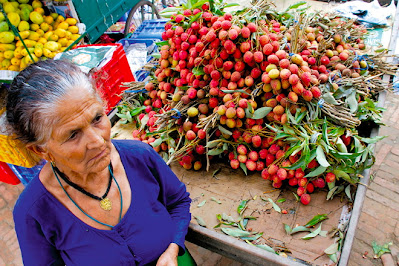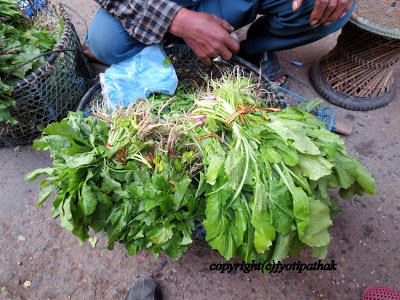Have you ever tried these wild greens - #Nettle Greens?
Sishnu ko Saag - (सिस्नु को साग)
 |
Nettle Greens - Com. name: Stinging Nettle, Bot.name: Urtica dioca L. Family: Urticaceae |
|
Stinging nettle or common nettle, Urtica dioica, is a herbaceous perennial flowering plant, native to Europe, Asia, northern Africa, and North America. It is the best-known member of the nettle genus Urtica. The plant has many hollow stinging hairs called trichomes on its leaves and stems, which act like hypodermic needles, injecting histamines and other chemicals that produce a stinging sensation when contacted by humans and other animals. The plant has a long history of use as a medicine and as a food source.......you can find about this on this site.

In the photo (left) - I was lucky enough to find a street vendor selling a bag full of nettle greens early in the morning near the Jana Baha area of Kathmandu. It is not common to see nettle greens sold like this since one has to go to the wild to collect it.
When nettle greens are picked or gathered, only uppermost tender shoots and top green leaves are picked. The older and mature leaves from the lower part of the plants are tasteless. The blue sweater lady told me the nettles were picked up by using Nepali metal tongs called chimta (चिम्टा). If you trying to explore and collect nettles from the wild, use rubber gloves, tongs or scissors. Make sure not to touch the shoots, leaves and plants with your bare hands. The stings of this plant is not a pleasant one.

Nepal's best kept secret among wild green vegetables, the nettle is prized for its taste, nutrient value (iron, vitamin A and C), and healing properties - the link here will help you read further about the amazing health benefits.
Sishnu ko saag is one of the most traditional wild vegetable growing like a wild-weed in many waste lands, walls, hedges and all over the central hill of Nepal. Nepalese have been eating unique vegetables for centuries and these have been an important food source for many. All the pictures that I uploaded in the blog here are Nepali variety of nettle greens that I captured in Nepal. I would like to share my early childhood memory of stinging nettle bush (sishnu ko jhaang - सिस्नु को झाँग) -- when playing with friends around the farmlands near the shaded and moist area, I accidentally bumped into and touched the bush of an angry nettle plants. The fuzzy hairs from the leaves gave me a bad sting with burning sensation, and I still have not forgotten the blisters. I was turned off and hesitant to try the nettles greens until later in my adulthood. When I was writing my cookbook, I have been meaning to try to cook and introduce the Nepali recipe on the book. Finally an elderly Nepali woman, Bhagawati bajai, showed me how to collect, cook and serve this vegetable. Below, I have posted her recipe from book Taste of Nepal.
Sishnu ko Tarkaari Recipe from The Taste of Nepal Cookbook - under vegetables - page 157
Many people find nettle greens reminiscent of spinach. I've heard from some describing the greens as mild flavored, earthy tasting greens and somewhat mixture of cucumber and spinach.
The street vendor in the Kathmandu market was selling freshly-picked stinging nettle greens at the open vegetable market. She was singing the song, "Saag re sisnu khaaeko aanandi manle"...
Most of us are familiar with the great Nepalese poet, Shree Laxmi Prasad Devkota, and his epic "Muna Madan". It is one of the most popular works in Nepali literature. He beautifully delivers the message in his poem to many young Nepalese who have gone to foreign lands to find work leaving their aging parents and family. The excerpt is about how one can be happy with just plain nettles greens in your own country than travelling to collect golds.
Haat kaa maila sun kaa thailaa, ke garnu dhanle? - (हातका मैला सुनका थैला, के गर्नु धनले )
Saag ra sisnu khaaeko besa aanandi manle! - (साग र सिस्नु खाएको बेस आनन्दी मनले)
Translation: Sacks of gold are like collected dirt on your hands, what is one to do with all these wealth?
It is better to eat nettles greens and cultivate happiness in your heart.
---------------------------------------------------
If you are a regular visitor to my blog, you will notice that I have been introducing unique vegetables that are grown and collected from the wilds in Nepal -- listed below are the link of my previous blog that you probably have gone through. They are Balsam Apple (barela - बरेला), Fiddlehead Fern (neuro - नीयूरो), Bauhinia (koiralo ko phool - कोइरालो), Pumpkin Shoots (pharsi ko munta - फर्सी को मुन्टा), Taro (karkalo-gaava-pidhaalu - कर्कलो-गाभा-पिँडालु), Tree Tomato (tyammatar - ट्यामटर), Ash Gourd (kubhindo - कुभिन्डो), Banana Blossom (kera ko bungo - केराको बुङ्गो), Luffa Gourd - gheeraula (घीरौला, पाटे घीरौला), Pointed Gourd (parvar - परवर) and Chayote Squash (iskush - इस्कुश).-------------------------------------------------------
Here are some useful links that you may want to check it out.
"The Stinging Nettle – A paradoxical Green Goddess""Nettles Bring Spring To The Kitchen", by by Nicole SpiridakisHere is a recent article from New York Time on Stinging Nettle - "A chief in the Field-Nettles" and the recipe - (Nettle, Dandelion and Mint Soup), to read the article and recipe, please click here.
"Eat Your Wild Greens: "The Delectable Nettle" by Lara Katherine Mountain Colley
Enjoying unique Nettle Wine (सिस्नु को रक्सी) made in Nepal, manufactured by Sakaro Beverages.Nettlange is one of the popular Nepali wines in the local market, made from nettles and oranges.------
Please share your experience about nettle greens (sishnu ko saag) or give your suggestion on how you or your family gather this wild vegetables and prepare. Please give few tips on where to look for this greens in your area and post them in the comment section of this blog. I am always looking for more input. Thank you.



.jpg)











An eyebrow twitching is similar to an eyelid twitching. If you have ever experienced eyelid twitching, you must know how annoying it is. In this, eyelid muscles contract that most commonly affects the lower eyelid.
ReplyDeleteSimilarly, Eyebrow twitching occurs when small muscles in your eyebrows contract involuntarily. When this happens, the part of the eyebrow means the skin around your eyebrow rapidly shakes. It can last for just seconds or sometimes for several hours, and most of the eyebrow twitching can go without any treatment.
But do you know why it is necessary to treat eyebrow twitching? However, general eyebrow twitching doesn’t need to get treated as it resolves within a few seconds or minutes. But eyebrow twitching for long hours may cause Hemifacial Spasms, a health condition caused by damaged or irritated facial nerves. This health issue can generally happen on one side of the face and can expand beyond the eye.
eyebrow-twitching